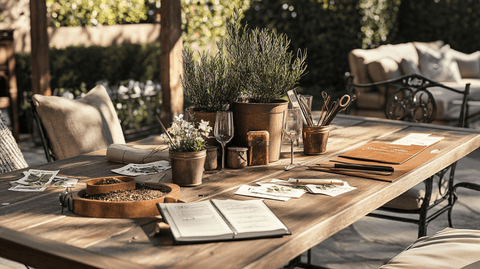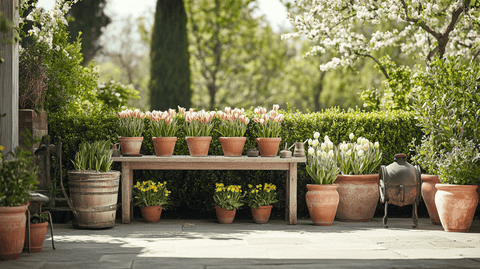Understanding the Southwest Florida Climate and Its Influence on Plant Life
Overview of Climate
Southwest Florida is renowned for its lush landscapes and abundant plant life, a reflection of its unique climate. Nestled between the tropical and subtropical zones, this region experiences distinctive weather patterns that greatly influence its vegetation.
Tropical and Subtropical Climate Zones
Southwest Florida enjoys a climate that fluctuates between tropical and subtropical. This blend results in mild, dry winters and hot, humid summers, creating a fertile growing ground for diverse plant species. These conditions are crucial for the successfully nurturing of both local and non-native plants.
Seasonal Variation
The seasonal shifts in Southwest Florida are not as pronounced as those in more temperate zones, but they are significant to the native flora. The rainy season, typically from May to October, brings heavy showers and thunderstorms, promoting rapid plant growth. Conversely, the dry season, from November to April, offers a respite with cooler, drier air, influencing the types of plants that can thrive. Understanding these seasonal shifts is vital for any gardener or conservationist working with the local ecosystem.

Key Native and Non-native Plants of Southwest Florida
Native Plant Species
Adonidia Palm
The Adonidia Palm, or "Christmas Palm," is a staple in Southwest Florida’s landscapes due to its elegant shape and manageable size. Known for its resilience to the local climate, it thrives in well-drained soils and sunny spots. Its festive red berries, which appear around December, provide natural decoration during the holiday season. This palm is available in various arrangements including single, double, and triple settings.
Agapanthus - Lily of the Nile
Another local favorite is the Agapanthus, commonly known as the Lily of the Nile. Its vibrant blue blooms and hardy nature make it a perfect candidate for gardens in this region. Agapanthus thrives in sunny areas and is especially drought-tolerant once established. Check out the blue varietals from Plantology to bring this beauty into your garden.
Non-native Ornamentals
Agave Varieties
The Agave plant, although not native, has become a beloved addition to Southwest Florida landscapes for its dramatic form and minimal water requirements. Popular varieties such as the Blue Agave, Caribbean Agave, and Desmettiana Variegata are celebrated for their adaptability and aesthetic appeal.
Landscaping with Southwest Florida Plants
Design Principles
When landscaping with Southwest Florida plants, consider the specific microclimates of your property. Utilize the natural beauty of the region with a focus on sustainability and conservation. Choose drought-tolerant species that require minimal irrigation once established.
Creating Wildlife Habitats
Incorporating native plants like the Adonidia Palm and Agapanthus in your garden not only beautifies your surroundings but also supports local wildlife. These plants provide shelter and food sources for native birds and insects, creating a vibrant ecosystem right in your backyard.

Common Challenges with Gardening in Southwest Florida
Soil Conditions
Southwest Florida's soil can vary significantly from sandy to clay, sometimes within a short distance. Adapting to these variances is crucial for successful gardening. Amending the soil with organic matter can help retain moisture and improve fertility.
Pests and Diseases
The warm, humid climate fosters a variety of garden pests such as whiteflies and aphids. Implementing integrated pest management practices and choosing pest-resistant plant species can mitigate these challenges.
Guide to Maintaining Your Southwest Florida Garden
Watering Techniques
Efficient irrigation is key in Southwest Florida. Drip or micro-irrigation systems help conserve water while delivering it directly to the roots where it is most needed. Consider installing rain barrels to capture and utilize rainwater during the wet season.
Pruning and Maintenance
Regular pruning helps maintain the health and appearance of your plants. It's essential to understand the growth habits of your specific plant species to avoid over-pruning and to promote optimal flowering and fruiting.
Fertilization Strategies
Southwest Florida plants often benefit from nutrient supplementation due to the poor native soil conditions. Use slow-release fertilizers that are tailored to the needs of your specific plant group.

Why Choose Plantology for Your Plant Needs?
Quality and Expertise
At Plantology, we offer a curated selection of plants tailored for the Southwest Florida climate. Our Alexander Palm and other quality selections are backed by expert guidance to ensure success in your gardening endeavors.
Dedication to Customer Satisfaction
Our knowledgeable team is ready to assist you in choosing the perfect plants for your home. Visit Plantology to explore our extensive inventory and begin your garden transformation today!
Conclusion
Embracing the beauty of Southwest Florida's diverse plant life can transform your garden into a tropical paradise. By understanding the local climate and plant characteristics, you can create a stunning, sustainable landscape that thrives year-round. Trust Plantology to supply both the plants and expertise to turn your gardening vision into reality.
Advanced Techniques for Sustainable Landscaping in Southwest Florida
Embracing Xeriscaping Principles
Xeriscaping is an innovative landscaping approach particularly suited for arid regions like Southwest Florida. This technique emphasizes the use of drought-tolerant plants, efficient irrigation methods, and thoughtful landscape design to reduce water consumption. By integrating xeriscaping principles, homeowners can significantly lower maintenance costs while fostering a sustainable garden ecosystem.
For example, instead of traditional lawns that require frequent watering and fertilization, consider installing ground covers such as Minor Rhus, which provide greenery with lower water needs. Combine these with native wildflowers that add splashes of color and attract pollinators, enhancing both the visual appeal and ecological value of your garden.

Innovative Water Management Strategies
Efficient water management is paramount in Southwest Florida gardening. Incorporating rainwater harvesting systems, such as rain barrels, allows gardeners to capture and reuse water during the dry season, minimizing the need for irrigation. Additionally, swales and berms can be designed to direct and absorb rainfall efficiently, reducing runoff and enhancing soil moisture retention.
Another effective technique is the use of mulch, which conserves soil moisture, moderates temperature fluctuations, and suppresses weed growth, thereby promoting healthier plant development. Organic mulches like pine straw or wood chips gradually break down, enriching the soil with nutrients over time.
Incorporating Permaculture Principles
Permaculture offers a holistic approach to landscape design that seeks to replicate the natural ecosystem. By observing and integrating natural patterns and relationships within the landscape, gardeners can create self-sustaining environments. Key permaculture practices include companion planting, where certain plants are paired together for mutual benefit, and utilizing biomass to improve soil health.
Consider planting nitrogen-fixing plants like Acacia, which improve soil fertility while supporting neighboring plant growth. Similarly, incorporating perennial vegetables and fruiting shrubs can yield long-term harvests with minimal intervention.
The Role of Microclimates in Garden Success
Identifying Microclimates
Understanding microclimates within your yard is crucial for optimizing plant health and performance. Microclimates are small-scale variations in climate caused by factors such as sunlight exposure, wind patterns, and proximity to structures or water features.
For instance, a south-facing wall may create a warmer microclimate ideal for heat-loving plants like succulents and cacti. Conversely, shaded areas beneath trees or along the north side of the house may harbor cooler, more humid conditions, favoring ferns or hostas.

Designing for Microclimates
By identifying the unique microclimates on your property, you can strategically place plants where they are most likely to thrive. This includes grouping sun-loving species together in exposed areas, while locating shade-tolerant varieties in cooler, sheltered spots.
Take into account the prevailing winds, which can influence plant structures and moisture levels. Wind barriers, such as hedges or trellises, can protect sensitive plants while enhancing the overall garden design.
Garden Integration with Local Wildlife
Creating Pollinator Gardens
Pollinator gardens are vital for supporting local biodiversity and promoting plant reproduction. By planting nectar-rich flowers that bloom at different times of the year, you can attract a wide variety of pollinators, including bees, butterflies, and hummingbirds.
Native plants, such as Milkweed, are excellent choices for pollinator gardens. They provide crucial habitat and food sources for Monarch butterflies and other pollinator species. Additionally, by avoiding the use of chemical pesticides, you can create a healthier environment that supports beneficial insects naturally controlling pest populations.
Building Bird-Friendly Landscapes
Birds contribute to a healthy garden ecosystem by controlling insects and dispersing seeds. To create a bird-friendly environment, integrate a mix of plant types, including trees, shrubs, and groundcovers that provide food, shelter, and nesting sites.
Consider installing bird feeders, bird baths, and nesting boxes to enhance your garden's appeal to avian visitors. Plants with berries, like Elderberry, offer natural food sources for a variety of bird species, encouraging their presence throughout the year.
Addressing Climate Change in Southwest Florida Gardening
Adapting to Altered Weather Patterns
Climate change poses challenges such as unpredictable weather patterns and increased frequency of extreme weather events. Southwest Florida gardeners must adapt their practices to mitigate the impact of these changes and ensure garden resilience.
Enhance soil health by incorporating organic matter to improve water retention and prevent erosion during heavy rains. Select plant varieties with increased heat and drought tolerance, optimizing the chances of survival and productivity under changing conditions.

Promoting Climate-Resilient Plant Selections
Choosing climate-resilient plant species is integral to developing a sustainable garden. These plants are characterized by their ability to withstand variable weather conditions, reducing reliance on supplemental irrigation and fertilizers.
Species such as Bahama Strongbark thrive in diverse environments and offer benefits like shade, habitat, and aesthetic value, making them ideal for adjusting landscapes to meet new climatic demands.
Community Engagement and Conservation Initiatives
Participating in Local Gardening Groups
Joining local gardening clubs or conservation groups provides opportunities to share knowledge, resources, and enthusiasm for sustainable practices. Collaboration within these communities fosters a collective effort toward environmental conservation and climate resilience.
Organize neighborhood workshops focused on sustainable gardening techniques, exchanging plant cuttings or seeds, and coordinating community improvement projects to beautify public spaces.
Supporting Native Plant Restoration
Contributing to native plant restoration efforts helps preserve Southwest Florida's unique biodiversity. Volunteer with local conservation organizations that focus on restoring local habitats and combating invasive species.
Incorporating native plants in your own garden supports these broader initiatives, maintaining genetic diversity and aiding the restoration of natural ecosystems. Encourage neighbors to do the same, multiplying the positive impact of these efforts.
Technological Innovations in Southwest Florida Gardening
Smart Plant Monitoring Systems
Advancements in technology offer modern solutions for efficient garden maintenance. Smart plant monitoring systems, equipped with sensors, enable real-time tracking of soil moisture, temperature, and light conditions, ensuring optimal plant care.
These systems can automatically alert users when plants require watering or adjustments in environmental conditions, streamlining garden management and promoting plant health with less effort.
Integrating Renewable Energy for Garden Solutions
Renewable energy applications, such as solar-powered lighting and irrigation pumps, contribute to sustainable garden practices. Solar lights can illuminate pathways without increasing electricity consumption, while solar pumps ensure efficient water distribution without draining resources.
By integrating renewable energy solutions, gardeners not only reduce their carbon footprint but also contribute to energy conservation and cost savings over time.
The Future of Southwest Florida Gardens
Innovative Trends and Potential Developments
The future of gardening in Southwest Florida involves embracing innovation and sustainable practices. Trendsetting concepts like vertical gardening and hydroponics offer solutions for limited space while maximizing production and efficiency.
Community gardens and urban farms may play a significant role in addressing food security challenges, offering educational opportunities, and enhancing social bonds. Emphasizing sustainability and self-reliance, gardens will continue to evolve as vital elements within resilient communities.

Empowering the Next Generation of Gardeners
Educating and inspiring the next generation of gardeners is essential for safeguarding the future of Southwest Florida's landscapes. Provide educational programs and workshops for local schools and youth organizations to instill appreciation for the environment and teach essential horticultural skills.
Mentorship programs and youth gardening initiatives can empower young individuals to take active roles in conservation, fostering a deeper connection with nature and ensuring the longevity of sustainable practices.
Final Thoughts on Embracing Sustainability in Southwest Florida Gardens
Gardening in Southwest Florida is an enriching experience, combining the region's diverse flora, distinct climate, and unique ecological opportunities. By emphasizing sustainable practices and understanding the interconnectedness of natural systems, we can cultivate gardens that serve as sanctuaries and legacies for future generations.
Embrace innovation, community, and education as core elements in your gardening journey. With guidance from trusted resources like Plantology and dedication to ongoing learning, anyone can build and maintain a thriving, sustainable garden that positively influences both the local environment and global ecosystems.






























Comments (0)
There are no comments for this article. Be the first one to leave a message!